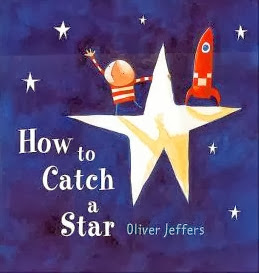Ad Astra: How to Catch a Star by Oliver Jeffers
ONCE THERE WAS A BOY
AND THE BOY LOVED STARS VERY MUCH.
Stargazing is good, but not enough for this boy, He wants to have a star he can hold in his hands.
He watches from his window through the night, hoping that a star will get tired and float down to him. It doesn't. He tries to lasso the star with a life preserver on a long rope. He misses.
He climbs a tree and reaches as high as he can, but he's not nearly high enough.
He knows that his paper rocket isn't really going anywhere.
It's hard to get close enough to a star to make friends.
Sadly the boy walks along the seaside and sees a star, just floating by. But when he reaches for it, it slips through his hands and away under the surface. But then on the beach, he sees a star, high and dry on the sand, one he can take home and keep for himself.
SOMETIMES YOU REACH FOR THE STARS AND MISS... AND REACH SOMETHING MUCH BETTER.
"Ah, but a man's reach should exceed his grasp, Or what's a heaven for?" wrote poet Robert Browning, and that is the boy's dilemma here. What he thinks he must have is far beyond his reach. Or is it? In Oliver Jeffers' How to Catch a Star
Of course, there is a lot more to Jeffers' little fable here, which youngsters will sense if not fully comprehend--the longing for a soulmate, the conquest of the world in which we find ourselves, or the simple desire to possess something beautiful. As illustrator, Jeffers hints at the symbolic nature of his story by making his stars as asymmetrical as a child's sketch, his trees vaguely round shapes done with a couple of swipes of paint, changing from blue to gold to orange to show the time of day, and his star seeker a simple stick figure, all ambiguous enough to become whatever the viewer wants it to be and yet clearly what it represents. Jeffers' story is pensive, yet humorous,
 respectful to a child's yearning for something he can't quite possess.
respectful to a child's yearning for something he can't quite possess.Read this one along with Kevin Henkes' 2005 Caldecott-winning Kitten's First Full Moon,



0 Comments:
Post a Comment
<< Home